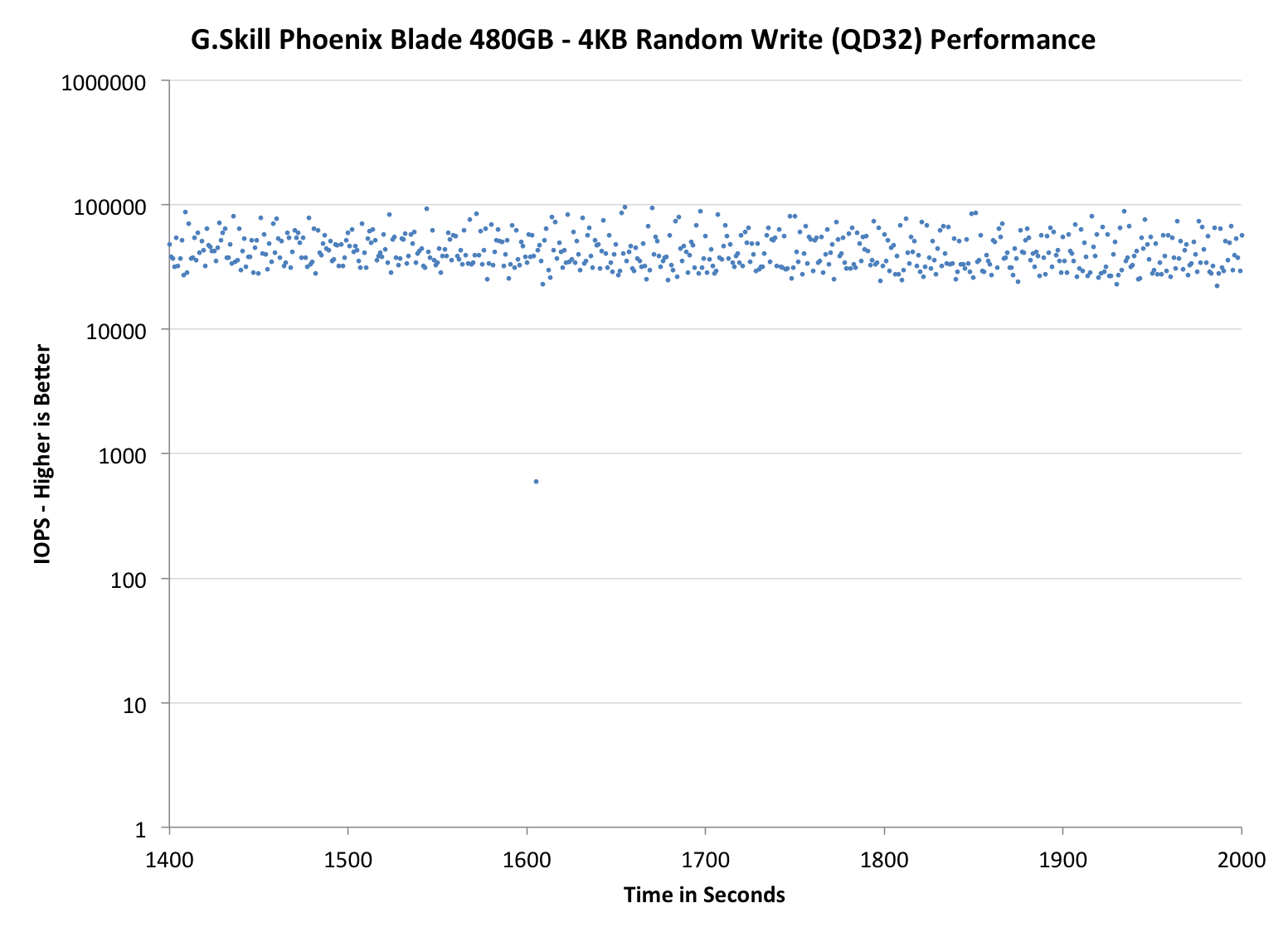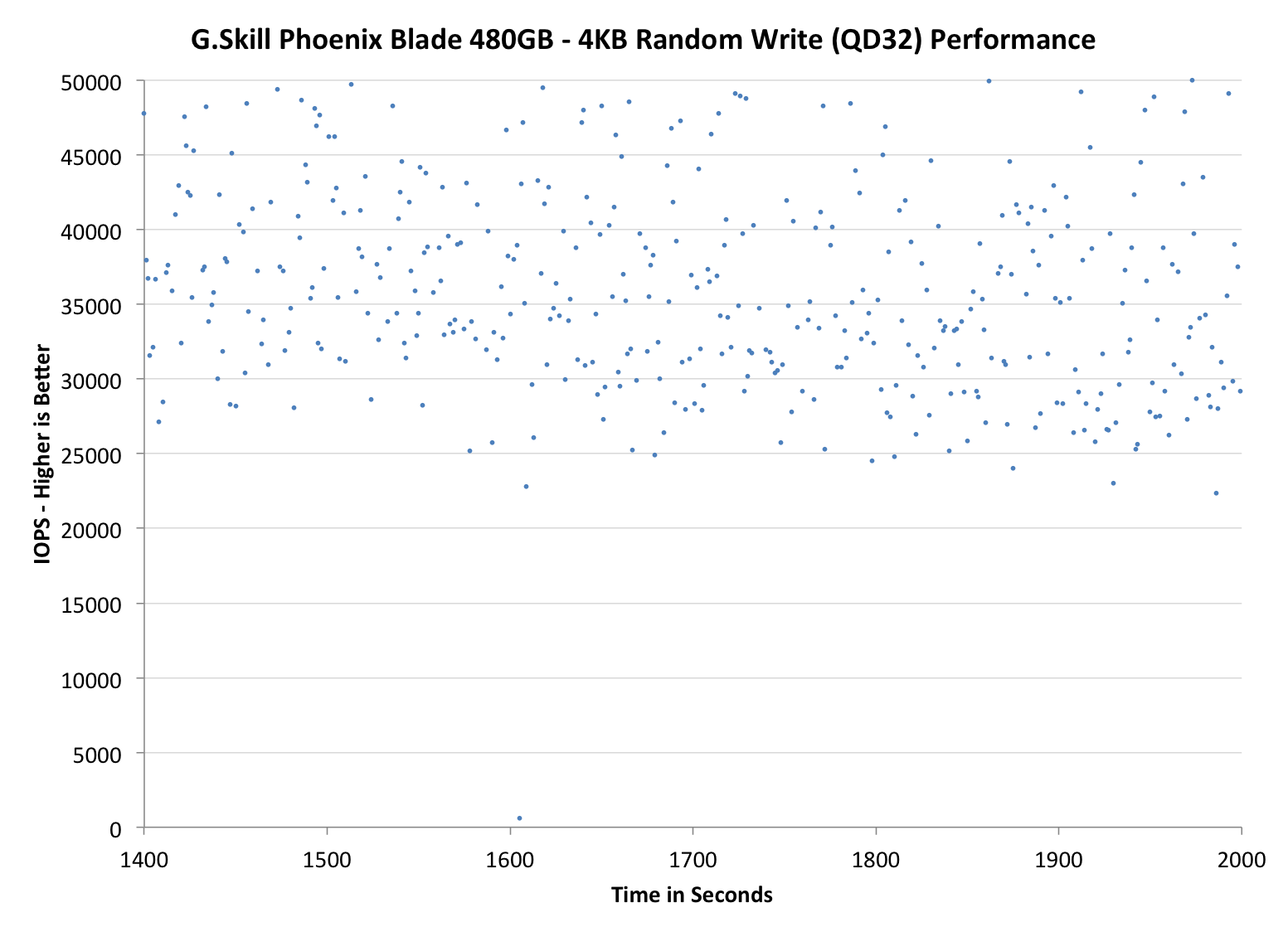G.Skill Phoenix Blade (480GB) PCIe SSD Review
by Kristian Vättö on December 12, 2014 9:02 AM ESTPerformance Consistency
Performance consistency tells us a lot about the architecture of these SSDs and how they handle internal defragmentation. The reason we do not have consistent IO latency with SSDs is because inevitably all controllers have to do some amount of defragmentation or garbage collection in order to continue operating at high speeds. When and how an SSD decides to run its defrag or cleanup routines directly impacts the user experience as inconsistent performance results in application slowdowns.
To test IO consistency, we fill a secure erased SSD with sequential data to ensure that all user accessible LBAs have data associated with them. Next we kick off a 4KB random write workload across all LBAs at a queue depth of 32 using incompressible data. The test is run for just over half an hour and we record instantaneous IOPS every second.
We are also testing drives with added over-provisioning by limiting the LBA range. This gives us a look into the drive’s behavior with varying levels of empty space, which is frankly a more realistic approach for client workloads.
Each of the three graphs has its own purpose. The first one is of the whole duration of the test in log scale. The second and third one zoom into the beginning of steady-state operation (t=1400s) but on different scales: the second one uses log scale for easy comparison whereas the third one uses linear scale for better visualization of differences between drives. Click the dropdown selections below each graph to switch the source data.
For more detailed description of the test and why performance consistency matters, read our original Intel SSD DC S3700 article.
 |
|||||||||
| Default | |||||||||
| 25% Over-Provisioning | |||||||||
Even though the Phoenix Blade and RevoDrive 350 share the same core controller technology, their steady-state behaviors are quite different. The Phoenix Blade provides quite substantially higher peak IOPS (~150K) and it is also more consistent in steady-state as the RevoDrive frequently drops below 20K IOPS while the Phoenix Blade doesn't.
 |
|||||||||
| Default | |||||||||
| 25% Over-Provisioning | |||||||||
 |
|||||||||
| Default | |||||||||
| 25% Over-Provisioning | |||||||||
TRIM Validation
To test TRIM, I turned to our regular TRIM test suite for SandForce drives. First I filled the drive with incompressible sequential data, which was followed by 60 minutes of incompressible 4KB random writes (QD32). To measure performance before and after TRIM, I ran a one-minute incompressible 128KB sequential write pass.
| Iometer Incompressible 128KB Sequential Write | |||
| Clean | Dirty | After TRIM | |
| G.Skill Phoenix Blade 480GB | 704.8MB/s | 124.9MB/s | 231.5MB/s |
The good news here is that the drive receives the TRIM command, but unfortunately it doesn't fully restore performance, although that is a known problem with SandForce drives. What's notable is that the first LBAs after the TRIM command were fast (+600MB/s), so in due time the performance across all LBAs should recover at least to a certain point.










62 Comments
View All Comments
personne - Friday, December 12, 2014 - link
Oh nice, how did I miss that? Must have been thinking of another site. Thanks.vLsL2VnDmWjoTByaVLxb - Friday, December 12, 2014 - link
"there is a market in users with older motherboards for whom the XP941 is simply not an option due to the lack of boot support."Presumably an enthusiast or one in the higher-end workstation markets would already have a suitable boot device so I don't see this as a hindrance. This is already a high-end product, so buying a motherboard to fit the niche would be expected.
Kinda like you don't bemoan a high-power GPU for it's inability to work on low-power supply systems.
Kristian Vättö - Friday, December 12, 2014 - link
I'm not sure I agree with this. Many enthusiasts/professionals haven't seen the appeal to upgrade from Sandy/Ivy Bridge setups, so it's not just the motherboard that needs to be updated.DanNeely - Friday, December 12, 2014 - link
I definitely don't agree with it. The only reason I'm planning to replace the core of my even older i7-930 system is that it's gotten old enough that an old age failure is becoming more likely and I don't want to do a rush upgrade when something catastrophically fails.hojnikb - Friday, December 12, 2014 - link
And i'm just here, expection a native pci-e solution.... Damn, raid0 sandforce is really annoying. Atleast use a proper controller, like marvell.And trim still doesn't seem to work properly...
UltraWide - Friday, December 12, 2014 - link
Would it be more prudent to wait for an NVMe based PCIe SSD? Maybe the Intel DC P3500 that is about to start selling in the next few weeks?Kristian Vättö - Friday, December 12, 2014 - link
I thought about mentioning the P3500, but it's been "about to start selling in the next few weeks" for the past six months, so I decided not to mention it since there is still no real schedule for its release.Luke212 - Friday, December 12, 2014 - link
Kristian why does noone bother to bench to P3600? I only need read performance and the P3600 might be suitable. its cutting edge tech yet noone has bothered to review it!Kristian Vättö - Saturday, December 13, 2014 - link
Intel hasn't sampled media with the P3600, that's why.otherwise - Monday, December 15, 2014 - link
I too have been waiting for this drive, but considering it was pulled from Intel's website, I don't think we're going to see it. I am going to guess that Intel though it would completely cannibalize P3600 sales, which it probably will if it sees the light of day.